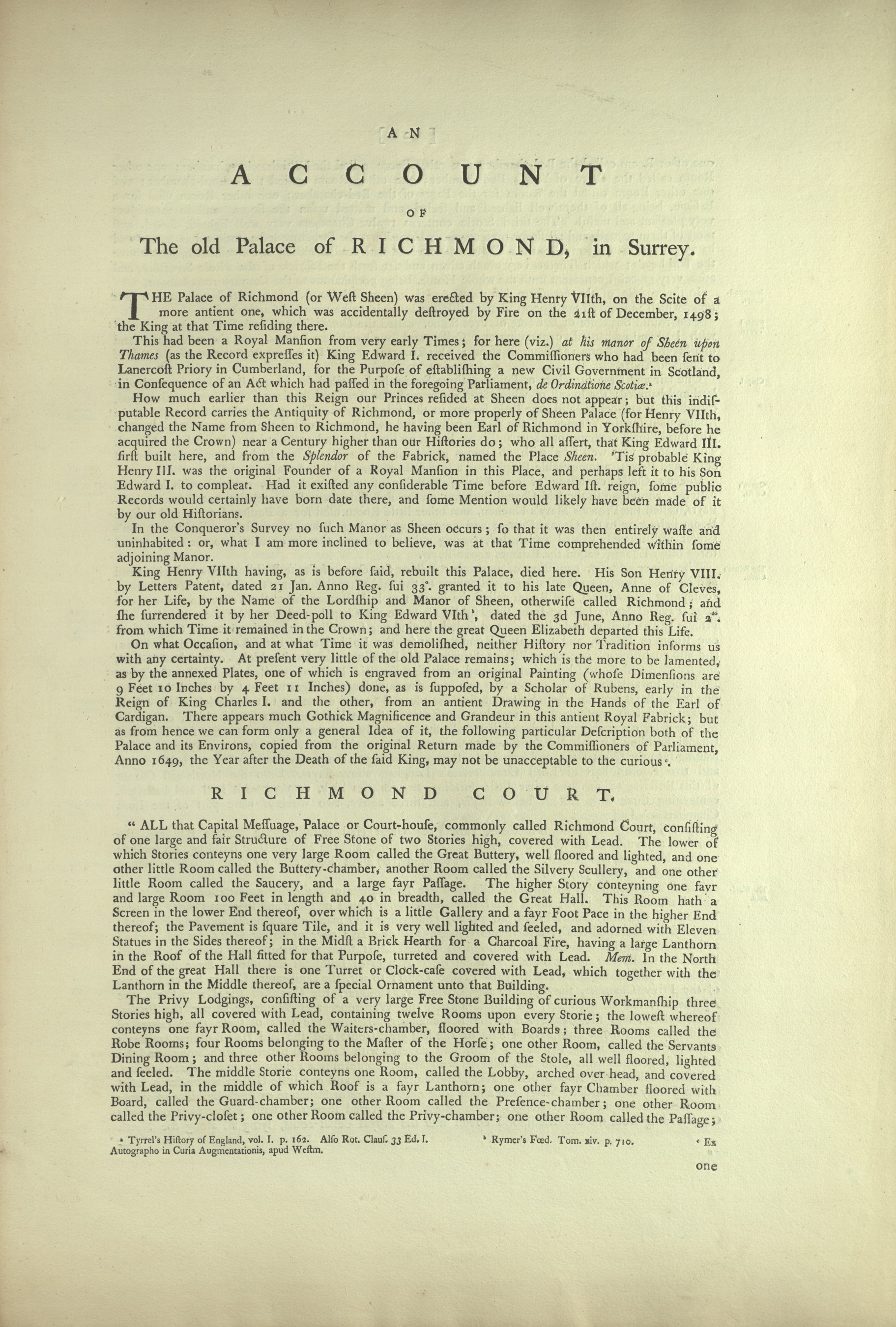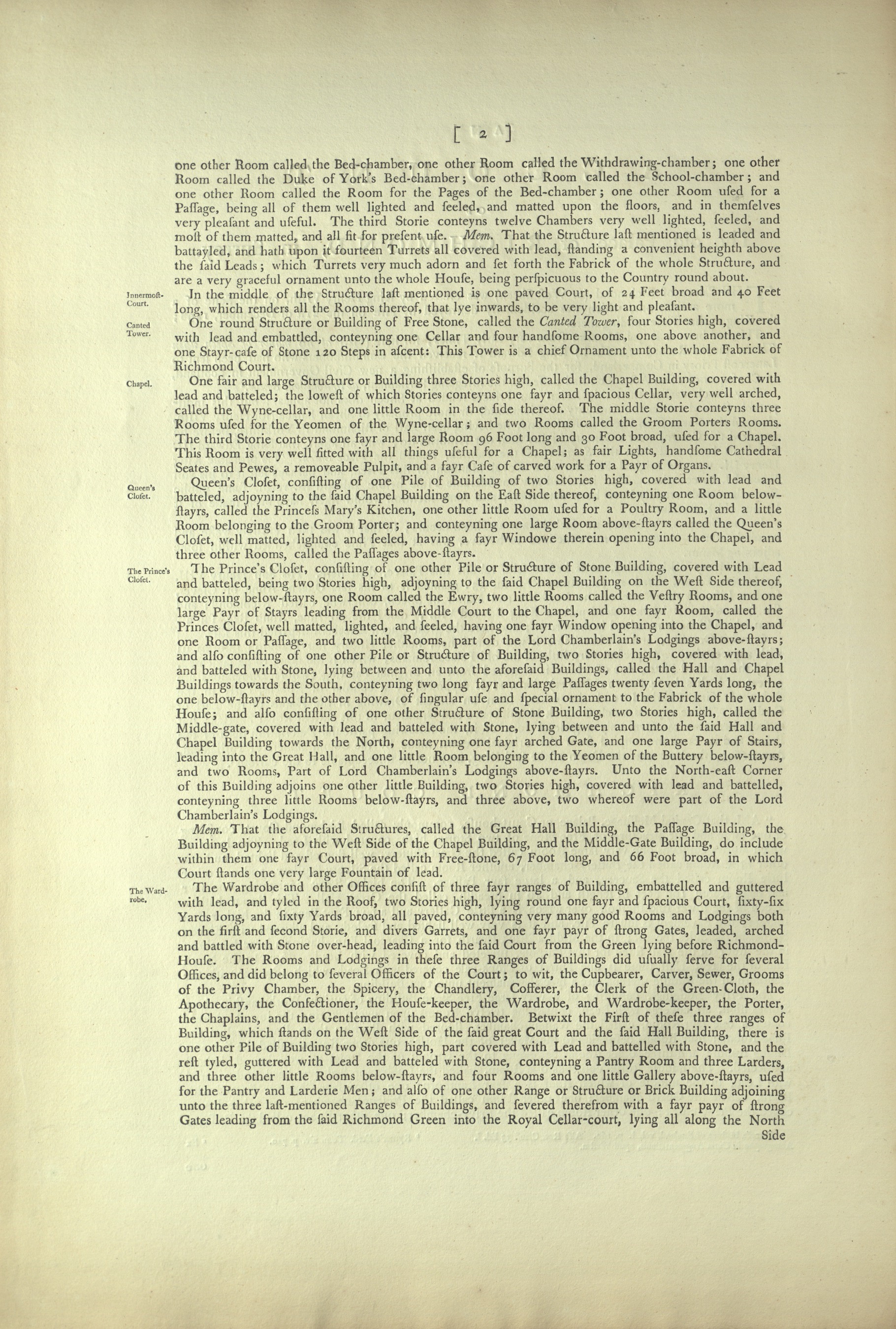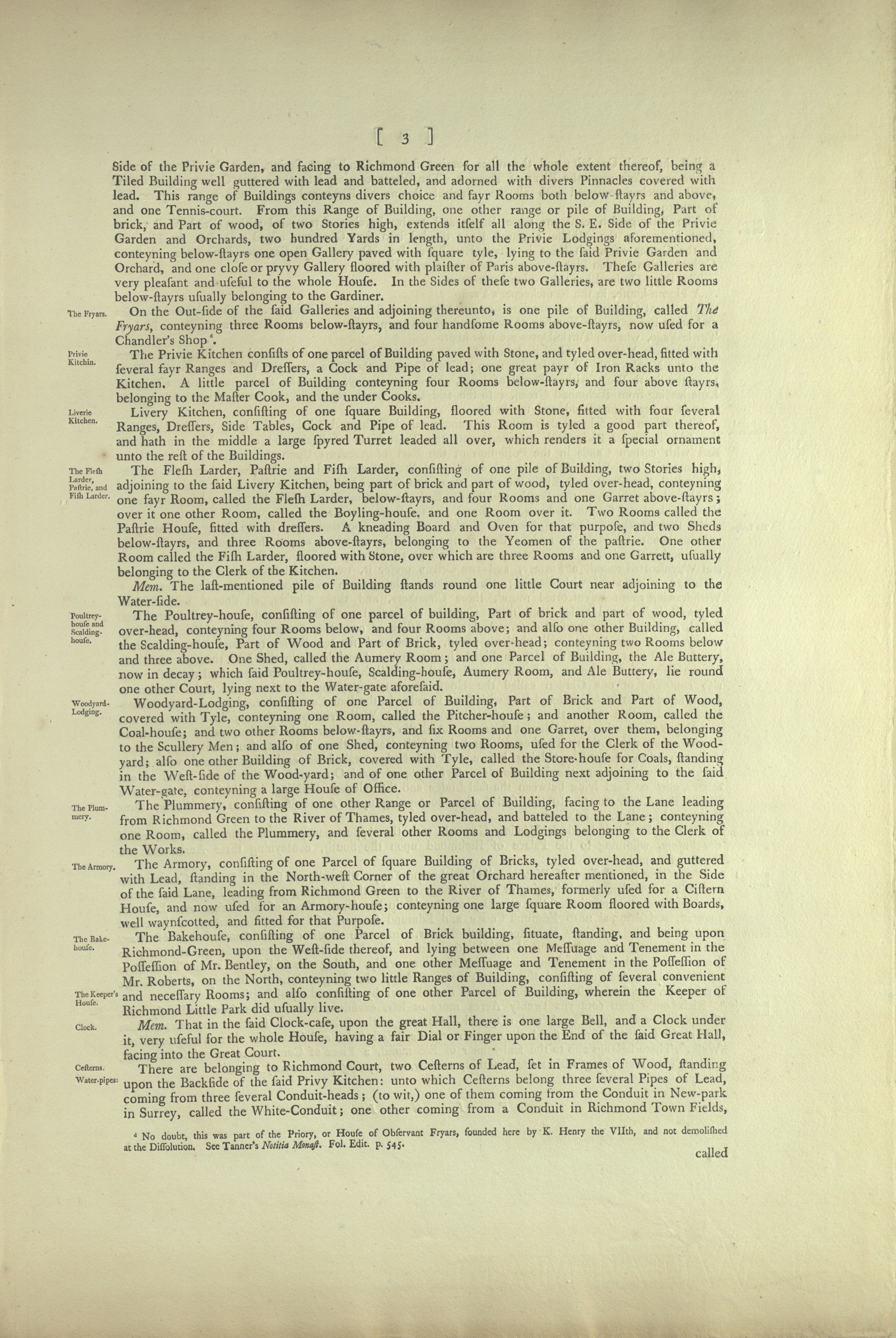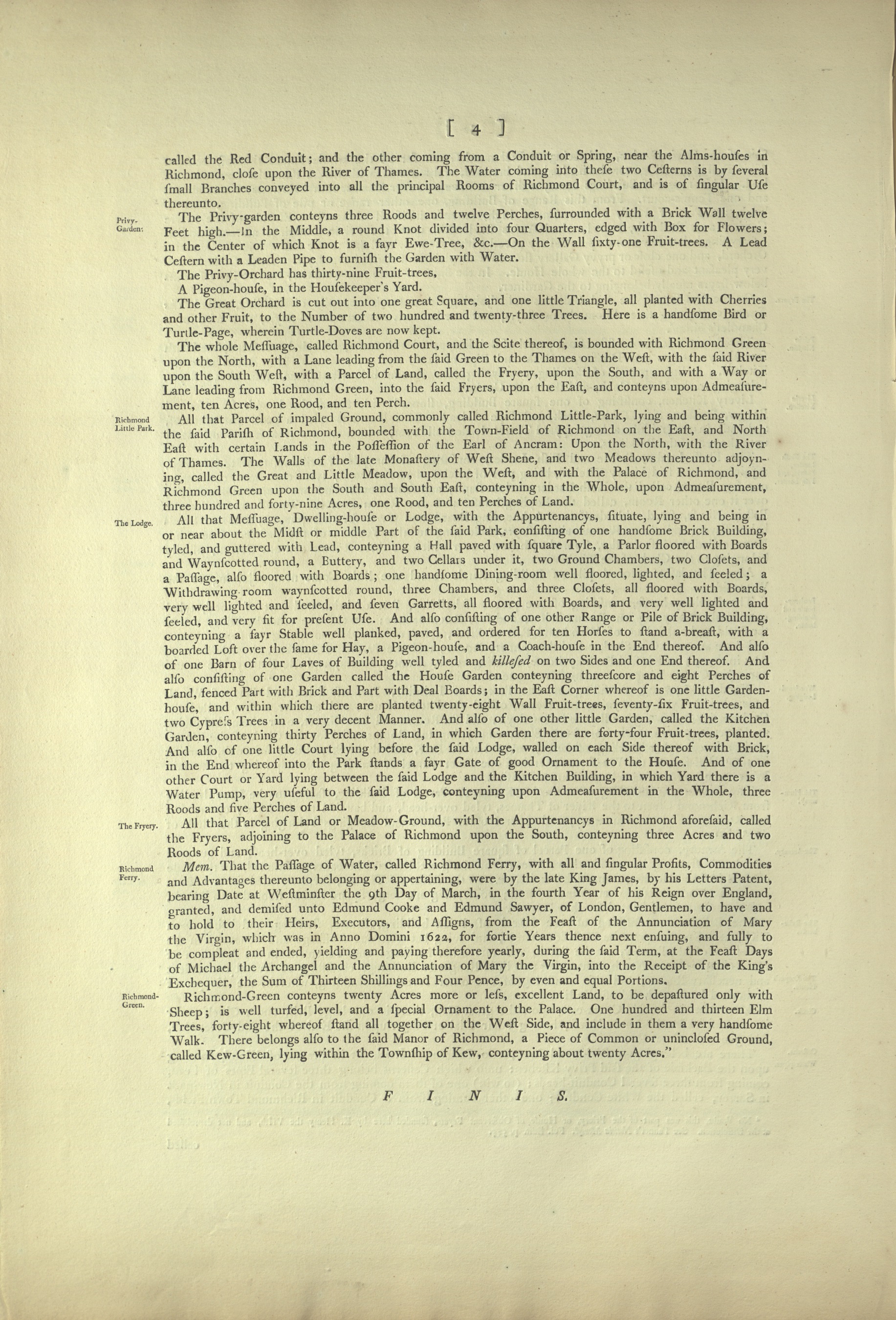
Creative Commons Attribution-Noncommercial-No Derivative Works 3.0
Plates 2.23-2.24: Richmond and Nonsuch Palaces (Original Explanatory Account)
1 media/vm1-02-cropped.jpg 2020-06-25T14:01:23+00:00 Ariel Fried f6b6cec26c5a46c3beae9e3505bac9e8799f51de 31 15 Original Explanatory Account for Vetusta Monumenta, Plates 2.23-2.24. Written by Charles Lyttelton. plain 2021-03-26T17:58:12+00:00 Crystal B. Lake b7829cc6981c2837dafd356811d9393ab4d81adc
[(Page) 1]
AN ACCOUNT OF The old Palace of RICHMOND, in Surrey.
THE Palace of Richmond (or West Sheen) was erected by King Henry VIIth, on the Scite of a more antient one, which was accidentally destroyed by Fire on the 21st of December, 1498; the King at that Time residing there.
This had been a Royal Mansion from very early Times; for here (viz.) at his manor of Sheen upon Thames (as the Record expresses it) King Edward I. received the Commissioners who had been sent to Lanercost Priory in Cumberland, for the Purpose of establishing a new Civil Government in Scotland, in Consequence of an Act which had passed in the foregoing Parliament, de Ordinatione Scotiae [translation here].a
How much earlier than this Reign our Princes resided at Sheen does not appear; but this indisputable Record carries the Antiquity of Richmond, or more properly of Sheen Palace (for Henry VIIth, changed the Name from Sheen to Richmond, he having been Earl of Richmond in Yorkshire, before he acquired the Crown) near a Century higher than our Histories do; who all assert, that King Edward III. first built here, and from the Splendor of the Fabrick, named the Place Sheen. ‘Tis probable King Henry III. was the original Founder of a Royal Mansion in this Place, and perhaps left it to his Son Edward I. to compleat. Had it existed any considerable Time before Edward Ist. reign, some public Records would certainly have born date there, and some Mention would likely have been made of it by our old Historians.
In the Conqueror’s Survey no such Manor as Sheen occurs; so that it was then entirely waste and uninhabited: or, what I am more inclined to believe, was at that Time comprehended within some adjoining Manor.
King Henry VIIth having, as is before said, rebuilt this Palace, died here. His Son Henry VIII. by Letters Patent, dated 21 Jan. Anno Reg. sui 33o. granted it to his late Queen, Anne of Cleves, for her Life, by the Name of the Lordship and Manor of Sheen, otherwise called Richmond; and she surrendered it by her Deed-poll to King Edward VIthb, dated the 3d June, Anno Reg. sui 2do. from which Time it remained in the Crown; and here the great Queen Elizabeth departed this Life.
On what Occasion, and at what Time it was demolished, neither History nor Tradition informs us with any certainty. At present very little of the old Palace remains; which is the more to be lamented, as by the annexed Plates, one of which is engraved from an original Painting (whose Dimensions are 9 Feet 10 Inches by 4 Feet 11 Inches) done, as is supposed, by a Scholar of Rubens, early in the Reign of King Charles I. and the other, from an antient Drawing in the Hands of the Earl of Cardigan. There appears much Gothick Magnificence and Grandeur in this antient Royal Fabrick; but as from hence we can form only a general Idea of it, the following particular Description both of the Palace and its Environs, copied from the original Return made by the Commissioners of Parliament, Anno 1649, the Year after the Death of the said King, may not be unacceptable to the curiousc.
R I C H M O N D C O U R T.
“ALL that Capital Messuage, Palace or Court-house, commonly called Richmond Court, consisting of one large and fair Structure of Free Stone of two Stories high, covered with Lead. The lower of which Stories conteyns one very large Room called the Great Buttery, well floored and lighted, and one other little Room called the Buttery-chamber, another Room called the Silvery Scullery, and one other little Room called the Saucery, and a large fayr Passage. The higher Story conteyning one fayr and large Room 100 Feet in length and 40 in breadth, called the Great Hall. This Room hath a Screen in the lower End thereof, over which is a little Gallery and a fayr Foot Pace in the higher End thereof; the Pavement is square Tile, and it is very well lighted and seeled, and adorned with Eleven Statues in the Sides thereof; in the Midst a Brick Hearth for a Charcoal Fire, having a large Lanthorn in the Roof of the Hall fitted for that Purpose, turreted and covered with Lead. Mem. In the North End of the great Hall there is one Turret or Clock-case covered with Lead, which together with the Lanthorn in the Middle thereof, are a special Ornament unto that Building.
The Privy Lodgings, consisting of a very large Free Stone Building of curious Workmanship three Stories high, all covered with Lead, containing twelve Rooms upon each Storie; the lowest whereof conteyns one fayr Room, called the Waiters-chamber, floored with Boards; three Rooms called the Robe Rooms; four Rooms belonging to the Master of the Horse; one other Room, called the Servants Dining Room; and three other Rooms belonging to the Groom of the Stole, all well floored, lighted, and seeled. The middle Storie conteyns one Room, called the Lobby, arched over head, and covered with Lead, in the middle of which Roof is a fayr Lanthorn; one other fayr Chamber floored with Board, called the Guard-chamber; one other Room called the Presence-chamber; one other Room called the Privy-closet; one other Room called the Privy-chamber; one other Room called the Passage;
a Tyrrel’s History of England, vol. I. p. 162. Also Rot. Claus. 33 Ed. I.
b Rymer’s Foed. Tom. xiv. p. 710.
c Ex Autographo in Curia Augmentationis, apud Westm. [translation here]

[(Page) 2]
one other Room called the Bed-chamber, one other Room called the Withdrawing-chamber; one other Room called the Duke of York’s Bed-chamber; one other Room called the School-chamber; and one other Room called the Room for the Pages of the Bed-chamber; one other Room used for a Passage, being all of them well lighted and seeled, and matted upon the floors, and in themselves very pleasant and useful. perspicuous to the Country round about.
The third Storie conteyns twelve Chambers very well lighted, seeled, and most of them matted, and all fit for present use. Mem. That the Structure last mentioned is leaded and battayled, and hath upon it fourteen Turrets all covered with lead, standing a convenient heighth above the said Leads; which Turrets very much adorn and set forth the Fabrick of the whole Structure, and are a very graceful ornament unto the whole House, being
Innermost-Court. In the middle of the Structure last mentioned is one paved Court, of 24 Feet broad and 40 Feet long, which renders all the Rooms thereof, that lye inwards, to be very light and pleasant.
Canted Tower. One round Structure or Building of Free Stone, called the Canted Tower, four Stories high, covered with lead and embattled, conteyning one Cellar and four handsome Rooms, one above another, and one Stayr-case of Stone 120 Steps in ascent: This Tower is a chief Ornament unto the whole Fabrick of Richmond Court.
Chapel. One fair and large Structure or Building three Stories high, called the Chapel Building, covered with lead and batteled; the lowest of which Stories conteyns one fayr and spacious Cellar, very well arched, called the Wyne-cellar, and one little Room in the side thereof. The middle Storie conteyns three Rooms used for the Yeomen of the Wyne-cellar; and two Rooms called the Groom Porters Rooms. The third Storie conteyns one fayr and large Room 96 Foot long and 30 Foot broad, used for a Chapel. This Room is very well fitted with all things useful for a Chapel; as fair Lights, handsome Cathedral Seates and Pewes, a removeable Pulpit, and a fayr Case of carved work for a Payr of Organs.
Queen’s Closet. Queen’s Closet consisting of one Pile of Building of two Stories high, covered with lead and batteled, adjoyning to the said Chapel Building on the East Side thereof, conteyning one Room below-stayrs, called the Princess Mary’s Kitchen, one other little Room used for a Poultry Room, and a little Room belonging to the Groom Porter; and conteyning one large Room above-stayrs called the Queen’s Closet, well matted, lighted and seeled, having a fayr Windowe therein opening into the Chapel, and three other Rooms, called the Passages above-stayrs.
The Prince’s Closet. The Prince’s Closet, consisting of one other Pile or Structure of Stone Building, covered with Lead and batteled, being two Stories high, adjoyning to the said Chapel Building on the West Side thereof, conteyning below-stayrs, one Room called the Ewry, two little Rooms called the Vestry Rooms, and one large Payr of Stayrs leading from the Middle Court to the Chapel, and one fayr Room, called the Prince[’]s Closet, well matted, lighted, and seeled, having one fayr Window opening into the Chapel, and one Room or Passage, and two little Rooms, part of the Lord Chamberlain’s Lodgings above-stayrs; and also consisting of one other Pile or Structure of Building, two Stories high, covered with lead, and batteled with Stone, lying between and unto the aforesaid Buildings, called the Hall and Chapel Buildings towards the South, conteyning two long fayr and large Passages twenty seven Yards long, the one below-stayrs and the other above, of singular use and special ornament to the Fabrick of the whole House; and also consisting of one other Structure of Stone Building, two Stories high, called the Middle-gate, covered with lead and batteled with Stone, lying between and unto the said Hall and Chapel Building towards the North, conteyning one fayr arched Gate, and one large Payr of Stairs, leading into the Great Hall, and one little Room belonging to the Yeomen of the Buttery below-stayrs, and two Rooms, Part of Lord Chamberlain’s Lodgings above-stayrs. Unto the North-east Corner of this Building adjoins one other little Building, two Stories high, covered with lead and battelled, conteyning three little Rooms below-stayrs, and three above, two whereof were part of the Lord Chamberlain’s Lodgings.
Mem. That the aforesaid Structures, called the Great Hall Building, the Passage Building, the Building adjoyning to the West Side of the Chapel Building, and the Middle-Gate Building, do include within them one fayr Court, paved with Free-stone, 67 Foot long, and 66 Foot broad, in which Court stands one very large Fountain of lead.
The Wardrobe. The Wardrobe and other Offices consist of three fayr ranges of Building, embattelled and guttered with lead, and tyled in the Roof, two Stories high, lying round one fayr and spacious Court, sixty-six Yards long, and sixty Yards broad, all paved, conteyning very many good Rooms and Lodgings both on the first and second Storie, and divers Garrets, and one fayr payr of strong Gates, leaded, arched and battled with Stone over-head, leading into the said Court from the Green lying before Richmond-House. The Rooms and Lodgings in these three Ranges of Buildings did usually serve for several Offices, and did belong to several Officers of the Court; to wit, the Cupbearer, Carver, Sewer, Grooms of the Privy Chamber, the Spicery, the Chandlery, Cofferer, the Clerk of the Green-Cloth, the Apothecary, the Confectioner, the House-keeper, the Wardrobe, and Wardrobe-keeper, the Porter, the Chaplains, and the Gentlemen of the Bed-chamber. Betwixt the First of these three ranges of Building, which stands on the West Side of the said great Court and the said Hall Building, there is one other Pile of Building two Stories high, part covered with Lead and battelled with Stone, and the rest tyled, guttered with Lead and batteled with Stone, conteyning a Pantry Room and three Larders, and three other little Rooms below-stayrs, and four Rooms and one little Gallery above-stayrs, used for the Pantry and Larderie Men; and also of one other Range or Structure or Brick Building adjoining unto the three last-mentioned Ranges of Buildings, and severed therefrom with a fayr payr of strong Gates leading from the said Richmond Green into the Royal Cellar-court, lying all along the North

[(Page) 3]
Side of the Privie Garden, and facing to Richmond Green for all the whole extent thereof, being a Tiled Building well guttered with lead and batteled, and adorned with divers Pinnacles covered with lead. This range of Buildings conteyns divers choice and fayr Rooms both below-stayrs and above, and one Tennis-court.
From this Range of Building, one other range or pile of Building, Part of brick, and Part of wood, of two Stories high, extends itself all along the S.E. Side of the Privie Garden and Orchards, two hundred Yards in length, unto the Privie Lodgings aforementioned, conteyning below-stayrs one open Gallery paved with square tyle, lying to the said Privie Garden and Orchard, and one close or pryvy Gallery floored with plaister of Paris above-stayrs. These Galleries are very pleasant and useful to the whole House. In the Sides of these two Galleries, are two little Rooms below-stayrs usually belonging to the Gardiner.
The Fryars. On the Out-side of the said Galleries and adjoining thereunto, is one pile of Building, called The Fryars, conteyning three Rooms below-stayrs, and four handsome Rooms above-stayrs, now used for a Chandler’s shopd.
Privie Kitchin. The Privie Kitchen consists of one parcel of Building paved with Stone, and tyled over-head, fitted with several fayr Ranges and Dressers, a Cock and Pipe of lead; one great payr of Iron Racks unto the Kitchen. A little parcel of Building conteyning four Rooms below-stayrs, and four above stayrs, belonging to the Master Cook, and the under Cooks.
Liverie Kitchen. Liverie Kitchen, consisting of one square Building, floored with Stone, fitted with four several Ranges, Dressers, Side Tables, Cock and Pipe of lead. This Room is tyled a good part thereof, and hath in the middle a large spyred Turret leaded all over, which renders it a special ornament unto the rest of the Buildings.
The Flesh Larder, Pastrie, and Fish Larder. The Flesh Larder, Pastrie and Fish Larder, consisting of one pile of Building, two Stories high, adjoining to the said Livery Kitchen, being part of brick and part of wood, tyled over-head, conteyning one fayr Room, called the Flesh Larder, below-stayers, and four Rooms and one Garret above-stayrs; over it one other Room, called the Boyling-house, and one Room over it. Two Rooms called the Pastrie House, fitted with dressers. A kneading Board and Oven for that purpose, and two Sheds below-stayrs, and three Rooms above-stayrs, belonging to the Yeomen of the pastrie. One other Room called the Fish Larder, floored with Stone, over which are three Rooms and one Garrett, usually belonging to the Clerk of the Kitchen.
Mem. The last-mentioned pile of Building stands round one little Court near adjoining to the Water-side.
Poultrey-house and Scalding-house. The Poultrey-house, consisting of one parcel of building, Part of brick and part of wood, tyled over-head, conteyning four Rooms below, and four Rooms above; and also one other Building, called the Scalding-house, Part of Wood and Part of Brick, tyled over-head; conteyning two Rooms below and three above. One Shed, called the Aumery Room; and one Parcel of Building, the Ale Buttery, now in decay; which said Poultrey-house, Scalding-house, Aumery Room, and Ale Buttery, lie round one other Court, lying next to the Water-gate aforesaid.
Woodyard-Lodging. Woodyard-Lodging, consisting of one Parcel of Building, Part of Brick and Part of Wood, covered with Tyle, conteyning one Room, called the Pitcher-house; and another Room, called the Coal-house; and two other Rooms below-stayrs, and six Rooms and one Garret, over them, belonging to the Scullery Men; and also of one Shed, conteyning two Rooms, used for the Clerk of the Wood-yard; also one other Building of Brick, covered with Tyle, called the Store-house for Coals, standing in the West-side of the Wood-yard; and of one other Parcel of Building next adjoining to the said Water-gate, conteyning a large House of Office.
The Plummery. The Plummery, consisting of one other Range or Parcel of Building, facing to the Lane leading from Richmond Green to the River of Thames, tyled over-head, and batteled to the Lane; conteyning one Room, called the Plummery, and several other Rooms and Lodgings belonging to the Clerk of the Works.
The Armory. The Armory, consisting of one Parcel of square Building of Bricks, tyled over-head, and guttered with Lead, standing in the North-west Corner of the great Orchard hereafter mentioned, in the Side of the said Lane, leading from Richmond Green to the River of Thames, formerly used for a Cistern House, and now used for an Armory-house; conteyning one large square Room floored with Boards, well waynscotted, and fitted for that Purpose.
The Bakehouse. The Bakehouse, consisting of one Parcel of Brick building, situate, standing, and being upon Richmond-Green, upon the West-side thereof, and lying between the Messuage and Tenement in the Possession of Mr. Bentley, on the South, and one other Messuage and Tenement in the Possession of Mr. Roberts, on the North, conteyning two little Ranges of Buildings, consisting of several convenient and necessary Rooms; and also consisting of one other Parcel of Building, wherein the Keeper of Richmond Little Park did usually live.
Clock. Mem. That in the said Clock-case, upon the great Hall, there is one large Bell, and a Clock under it, very useful for the whole House, having a fair Dial or Finger upon the End of the said Great Hall, facing into the Great Court.
Cesterns. Water-pipes: There are belonging to Richmond Court, two Cesterns of Lead, set in Frames of Wood, standing upon the Backside of the said Privy Kitchen: unto which Cesterns belong three several Pipes of Lead, coming from three several Conduit-heads; (to wit,) one of them from the Conduit in New-park in Surrey, called the White-Conduit; one other coming from a Conduit in Richmond Town Fields,
d No doubt, this was part of the Priory, or House of Observant Fryers, founded here by K. Henry the VIIth, and not demolished at the Dissolution. See Tanner’s Notitia Monast. Fol. Edit. p. 545.

[(Page) 4]
called the Red Conduit; and other coming from a Conduit or Spring, near the Alms-houses in Richmond, close upon the River of Thames. The Water coming into these two Cesterns is by several small Branches conveyed into all the principal Rooms of Richmond Court, and is of singular Use thereunto.
Privy Garden: The Privy Garden conteyns three Roods and twelve Perches, surrounded with a Brick Wall twelve Feet high.—In the Middle, a round Knot divided into four Quarters, edged with Box for Flowers; in the Center of which Knot is a fayr Ewe-Tree, &c.—On the Wall sixty-one Fruit-trees. A Lead Cestern with a Leaden Pipe to furnish the Garden with Water.
The Privy-Orchard has thirty-nine Fruit-trees.
A Pigeon-house, in the Housekeeper’s Yard.
The Great Orchard is cut out into one great Square, and one little Triangle, all planted with Cherries and other Fruit, to the Number of two hundred and twenty-three Trees. Here is a handsome Bird or Turtle-Page, wherein Turtle-Doves are now kept.
The whole Messuage, called Richmond Court, and the Scite thereof, is bounded with Richmond Green upon the North, with a Lane leading from the said Green to the Thames on the West, with the said River upon the South West, with a Parcel of Land, called the Fryery, upon the South, and with a Way or Lane leading from Richmond Green, into the said Fryers, upon the East, and conteyns upon Admeasurement, ten Acres, one Rood, and ten Perch.
Richmond Little Park. All that Parcel of impaled Ground, commonly called Richmond Little-Park, lying and being within the said Parish of Richmond, bounded with the Town-Field of Richmond upon the East, and North East with certain Lands in the Possession of the Earl of Ancram: Upon the North, with the River of Thames. The Walls of the late Monastery of West Shene, and two Meadows thereunto adjoyning, called the Great and Little Meadow, upon the West, and with the Palace of Richmond, and Richmond Green upon the South and South East, conteyning in the Whole, upon Admeasurement, three hundred and forty-nine Acres, one Rood, and ten Perches of Land.
The Lodge. All that Messuage, Dwelling-house or Lodge, with the Appurtenancys, situate, lying and being in or near about the Midst or middle Part of the said Park, consisting of one handsome Brick Building, tyled, and guttered with Lead, conteyning a Hall paved with square Tyle, a Parlor floored with Boards and Waynscotted round, a Buttery, and two Cellars under it, two Ground Chambers, two Closets, and a Passage, also floored with Boards; one handsome Dining-room well floored, lighted, and seeled; a Withdrawing-room waynscotted round, three Chambers, and three Closets, all floored with Boards, very well lighted and seeled, and seven Garretts, all floored with Boards, and very well lighted and seeled, and very fit for present Use. And also consisting of one other Range or Pile of Brick Building, conteyning a fayr Stable well planked, paved, and ordered for ten Horses to stand a-breast, with a boarded Loft over the same for Hay, a Pigeon-house, and a Coach-house in the End thereof. And also of one Barn of four Laves of Building well tyled and killesed on two Sides and one End thereof. And also consisting of one Garden called the House Garden conteyning threescore and eight Perches of Land, fenced Part with Brick and Part with Deal Boards; in the East Corner whereof is one little Garden-house, and within which there are planted twenty-eight Wall Fruit-trees, seventy-six Fruit-trees, and two Cypress Trees in a very decent Manner. And also of one other little Garden, called the Kitchen Garden, conteyning thirty Perches of Land, in which Garden there are forty-four Fruit-trees, planted. And also of one little Court lying before the said Lodge, walled on each Side thereof with Brick, in the End whereof into the Park stands a fayr Gate of good Ornament to the House. And of one other Court or Yard lying between the said Lodge and the Kitchen Building, in which Yard there is a Water Pump, very useful to the said Lodge, conteyning upon Admeasurement in the Whole, three Roods and five Perches of Land.
The Fryery. All that Parcel of Land or Meadow-Ground, with the Appurtenancys in Richmond aforesaid, called the Fryers, adjoining to the Palace of Richmond upon the South, conteyning three Acres and two Roods of Land.
Richmond Ferry. Mem. That the Passage of Water, called Richmond Ferry, with all and singular Profits, Commodities and Advantages thereunto belonging or appertaining, were by the late King James, by his Letters Patent, bearing Date at Westminster the 9th Day of March, in the fourth Year of his Reign over England, granted, and demised unto Edmund Cooke and Edmund Sawyer, of London, Gentlemen, to have and to hold their Heirs, Executors, and Assigns, from the Feast of the Annunciation of Mary the Virgin, which was in Anno Domini 1622, for fortie Years thence next ensuing, and fully to be compleat and ended, yielding and paying therefore yearly, during the said Term, at the Feast Days of Michael the Archangel and the Annunciation of Mary the Virgin, into the Receipt of the King’s Exchequer, the Sum of Thirteen Shillings and Four Pence, by even and equal Portions.
Richmond-Green. Richmond-Green conteyns twenty Acres more or less, excellent Land, to be depastured only with Sheep; is well turfed, level, and a special Ornament to the Palace. One hundred and thirteen Elm Trees, forty-eight whereof stand all together on the West Side, and include in them a very handsome Walk. There belongs also to the said Manor of Richmond, a Piece of Common or uninclosed Ground, called Kew-Green, lying within the Township of Kew, conteyning about twenty Acres.”
F I N I S.